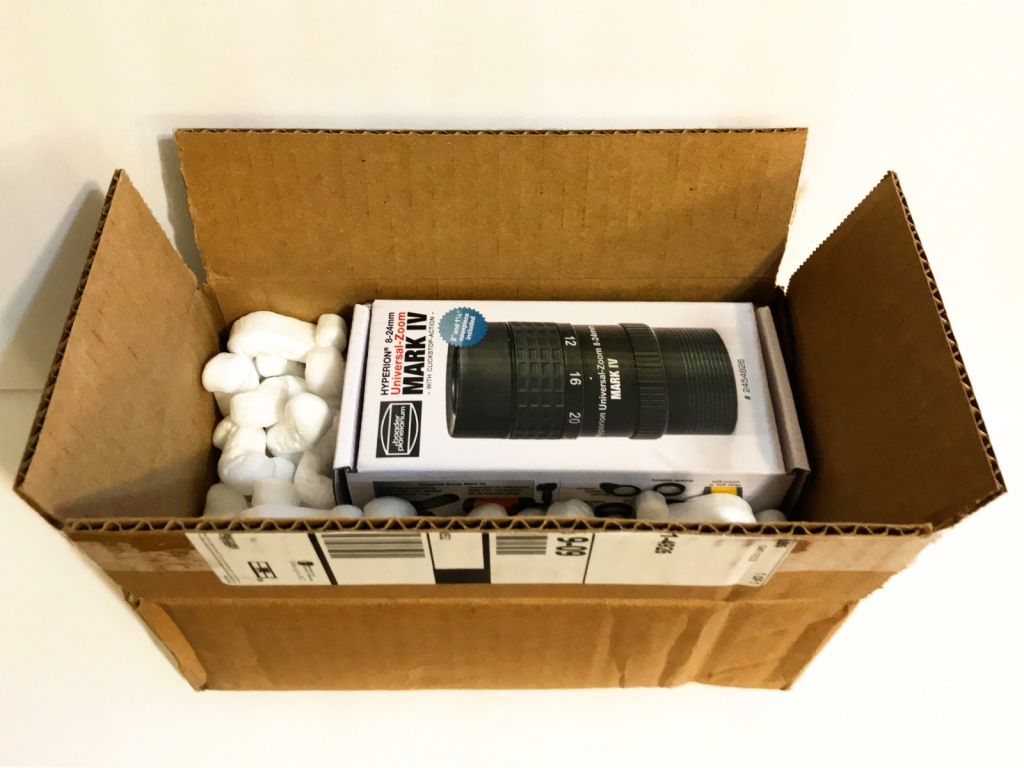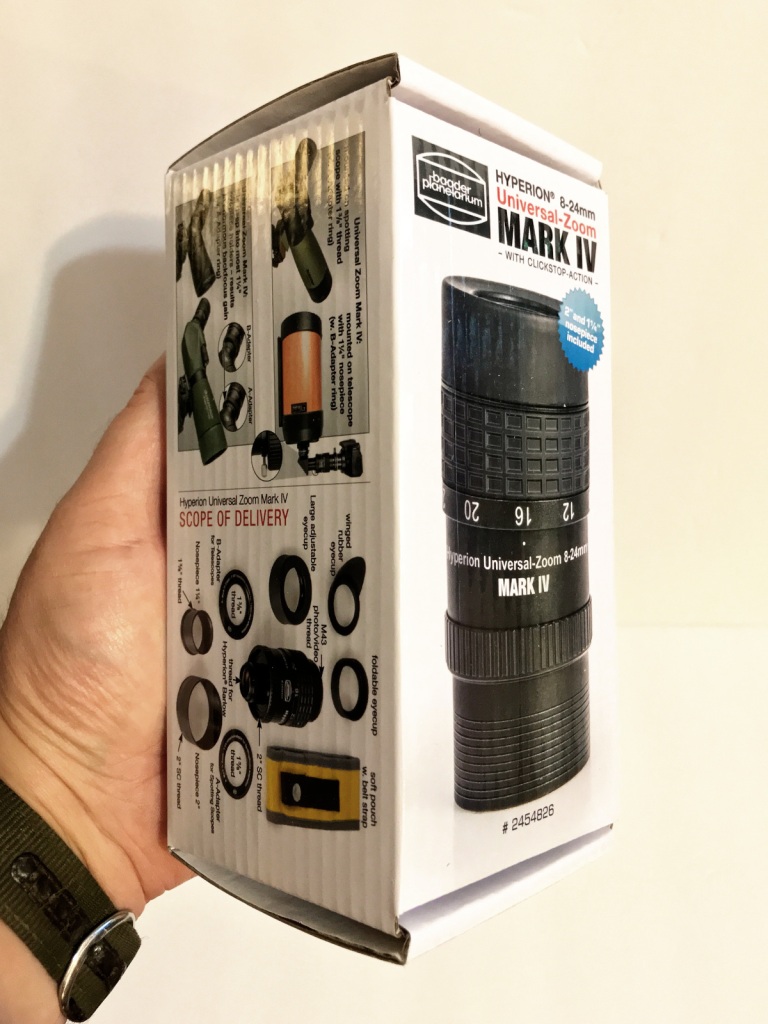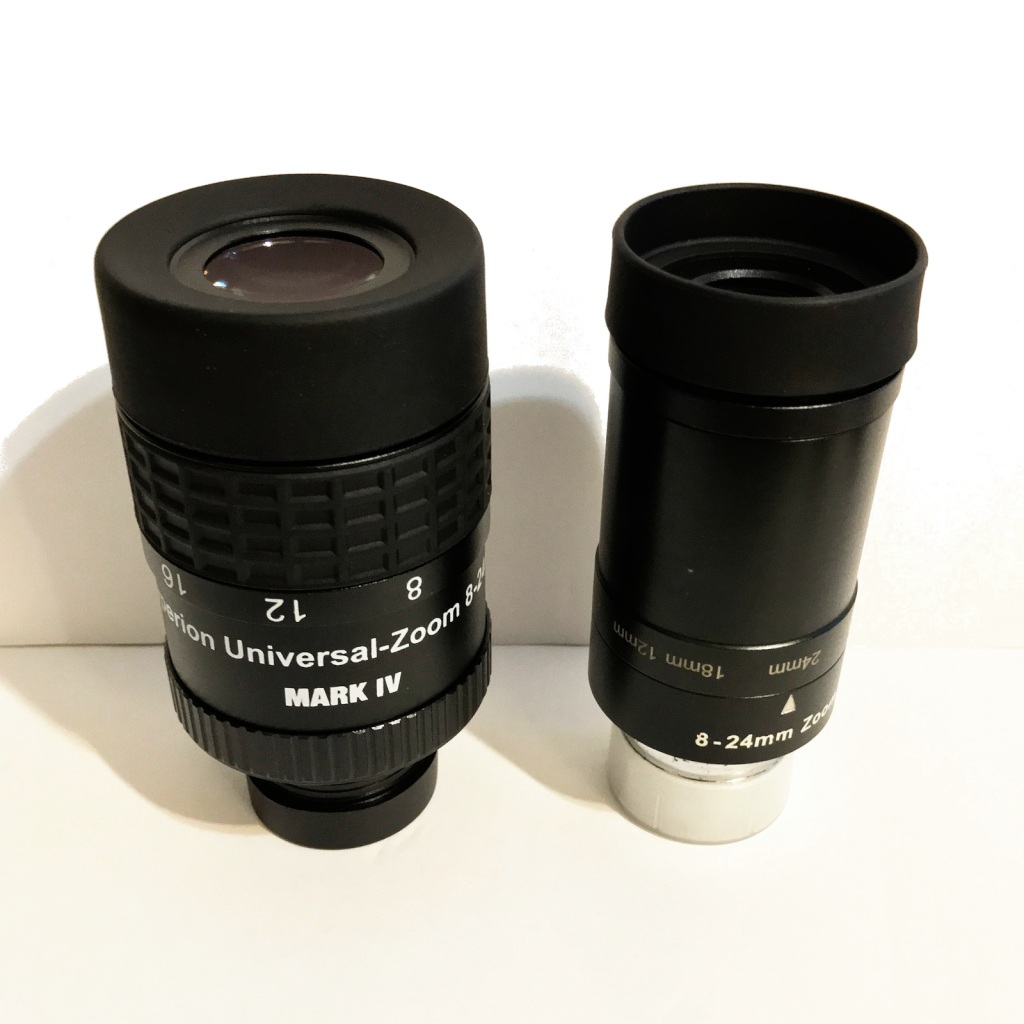
It has been a long, long time since I got a new eyepiece. Three and a half years since I got my Edmund 28mm RKE, and just under five years since I got my Meade 5mm MWA, which was the last “premium” eyepiece I picked up (the 28mm RKE is one of my all-time favorites and most-used eyepieces, but at $85 I don’t think it counts as “premium”–for however much or little that is worth!).

I have been wanting to try this Baader zoom for years and years. It has an almost unbelievably positive reputation on Cloudy Nights, where at least some observers report selling off a lot of their premium fixed-focal-length eyepieces after acquiring the Baader zoom.

Does it really live up to the hype? Thanks to a bolt of consulting money coming in last week, I’m about to find out.

I found it in stock at Woodland Hills Camera and Telescope, and one arrived on my doorstep a couple of days later, extremely well-packed. Since I ordered mine, Woodland Hills seems to have run out of the standalone eyepiece, although they still offer it bundled with the matching 2.25x Baader barlow, which I skipped, for a little more dough (here). Amazon has it in stock, but for a little more than most other outlets–$325 right now, versus $289 or so most other places (here).

There’s no instruction book inside the box–the box itself is the parts inventory and instruction manual. I really dig this. I think every other eyepiece I’ve ever owned has come in an unadorned box, some of them quite fancy and nice enough to repurpose as gift boxes for birthdays and holidays (looking at you, Explore Scientific). This box is functional. Every surface is illustrated, and most of the sides show you how to use the eyepiece in various situations.

Even when you open the box, there are more instructions on the newly-revealed surface! Who does that? As a catalog-junkie who likes looking a photos of gear, this box ticks all my, er, boxes.

Now this is kinda awesome, and kinda hilarious. Instead of coming in a bolt case, like my two Bresser eyepieces; or clamshell foam, like all of my Explore Scientifics; or a sturdy plastic can with a screw-on lid, like the Celestron 8-24mm zoom; or just dust caps inside the cardboard box, like all of my Orion eyepieces, the Baader Hyperion 8-24mm clickstop zoom comes in a rugged nylon pouch with a velcro closure and–as you can see in the inventory photo on the side of the box–a belt strap. And it’s high-visability yellow so you won’t lose it.
This is pretty cool, and definitely functional, and also amuses the heck out of me. This is the kind of case I expect for a multi-tool, or a handheld GPS unit, or some other thing you might take hiking, not a telescope eyepiece. I guess if you ever wanted to bushwhack across Utah or Patagonia with a high-end telescope eyepiece on your hip, or clipped to the side of your pack, now you are prepared. I imagine I’ll keep mine in my eyepiece case, like any normal person.

Here are the eyepiece and the extra bits, out of their respective bags. The four things in the extra bag are (clockwise from top) the winged rubber eyecup, the fold-down eyecup, the spotting scope adapter, and the dust cap that goes with the fold-down eyecup. The eyepiece itself comes in the bag with the larger dust cap on top of the adjustable eyecup, which rotates up and down, and with the 2″ adapter and its dustcap on the bottom end.
I should mention right here that both plastic bags were open, not sealed, which is good, because it prevents dew formation. The one for the accessories had one of the little silica gel packs, which I always steal to throw in with my meteorites. (Note to self: blog about new meteorite storage system soon.)

Pull the dustcap off the 2″ adapter and you find inside the smaller dustcap on the 1.25″ adapter. You could use the eyepiece in a 2″ focuser or diagonal with both the 1.25″ and 2″ adapters in place, and I’m not sure if there’s any benefit to taking the 1.25″ adapter off.

Here’s the adjustable eyecup in the down position…

…and twisted up. I’m a fan of these things–I notice that civilians are much less likely to stab the eye lens with a greasy finger* if there’s something in the way. Plus it’s nice to be able to signal to people where they should put their eyes, something that can be surprisingly tricky with eyepieces that have long eye relief.
* I’m not mocking n00bs or people who come to public star parties. To astronomical optical surfaces, all fingers are greasy.

Here’s the Baader compared to my Celestron 8-24mm zoom. The Celestron has been in service for a few years and eventually the knurled rubber wrap around the middle of the eyepiece split and fell off, which doesn’t impact the function whatsoever.
I like the Celestron a lot. It’s been one of my most-used eyepieces, and along with a 32mm Plossl it is hands down the eyepiece that I’ve recommended the most. Long-time readers may recall that when I flew to Texas in 2017 for the Three Rivers Messier Marathon, the only eyepieces I took were the 28mm RKE and this Celestron zoom, and they proved to be all the eyepieces I needed.
In fact, it was my positive experiences with the Celestron zoom that convinced me to venture the money for the Baader zoom. I rarely splurge like that for a piece of gear in a class I’ve never tried. In normal times, the Celestron zoom runs $65-$75. With the temporary shortage of astronomy gear because of increased demand during the pandemic, the price has spiked a bit, at least at some retailers. I see it going for just over $90 at Amazon (link).
If I have one knock on the Celestron zoom, it’s that it is ever-so-slightly less sharp than the best of my fixed-focal-length eyepieces. The difference is subtle–I would not have been able to spot it in my first 3-4 years of observing, and even now it takes a determined effort for me to see it–but it’s there. (As always, your eyes, your experience level, and your sample of this piece of equipment might vary from mine, and probably do.) Which is another reason I wanted to try the Baader, with its sterling reputation for clarity and sharpness. If it lives up to that, I will be using it a lot.

I haven’t pulled out a ruler, but the eye lenses of the two zooms look about the same size.

My kitchen scale says the Baader zoom weighs 10.4 oz, or 296 grams.

And the Celestron zoom weighs about 3/4 as much, 7.7 oz or 218 grams. I was pleasantly surprised by the lightness of the Baader; at least to me, it looks like it might weigh a little more.
With any luck, I’ll have a first-light report along soon. And there’s more unboxing coming soon–stay tuned!
